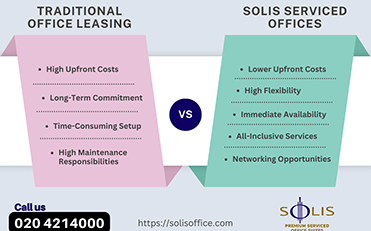
When deciding between traditional offices and serviced offices, it’s essential to understand the fundamental differences, benefits, and drawbacks of each. Here’s a detailed comparison:
Serviced Offices
Overview
Serviced offices are fully furnished and managed office spaces leased on a short-term, flexible basis. These offices come with a range of services, such as reception, cleaning, and IT support, included in the rental price.
Benefits
- Flexibility: Short-term leases provide flexibility to scale up or down quickly based on business needs.
- Lower Upfront Costs: Minimal initial investment as the space is already furnished and equipped.
- All-Inclusive Services: Access to shared amenities and services like reception, IT support, meeting rooms, and maintenance.
- Immediate Availability: Move-in ready, allowing businesses to start operating almost immediately.
- Networking Opportunities: Shared spaces can facilitate networking and collaboration with other businesses.
Drawbacks
- Less Customization: Limited ability to customize the space according to specific company needs and branding.
- Shared Amenities: Shared facilities may sometimes lead to scheduling conflicts or lack of privacy.
- Variable Quality: The quality of services and facilities can vary significantly between providers.
Traditional Offices
Overview
Traditional offices are spaces leased directly from a landlord, usually on a long-term basis (often several years). Tenants are responsible for fitting out, furnishing, and managing the office.
Benefits
- Customization: Tenants can design and furnish the space to meet their specific needs and company culture.
- Branding: Complete control over the branding and layout of the office space.
- Stability: Long-term leases provide stability and predictability.
- Scalability: Larger companies with consistent growth may find traditional offices more scalable over time.
Drawbacks
- High Upfront Costs: Initial costs can be significant due to deposits, fit-out expenses, furniture, and IT infrastructure setup.
- Long-Term Commitment: Long-term leases can be inflexible, making it difficult to adapt to changing business needs.
- Maintenance Responsibilities: Tenants are responsible for maintenance, utilities, and other overheads.
- Time-Consuming Setup: Setting up and managing the space can be time-consuming and distract from core business activities.
Choosing the Right Option
Considerations for Traditional Offices
- Long-Term Stability: Ideal for companies with stable, long-term growth and the need for a permanent location.
- Customization Needs: Suitable for businesses that require a high degree of customization and branding control.
- Large Teams: Often more cost-effective for larger teams when spread out over a longer lease period.
Considerations for Serviced Offices
- Flexibility: Perfect for startups, small businesses, or rapidly growing companies that need the flexibility to scale.
- Cost Management: Beneficial for companies looking to manage costs and avoid large upfront investments.
- Immediate Setup: Ideal for businesses needing to be operational quickly without the hassle of setting up an office.
The choice between traditional and serviced offices depends on the specific needs, financial situation, and growth trajectory of your business. Traditional offices offer long-term stability and customization, while serviced offices provide flexibility and convenience with lower initial costs. Assessing these factors will help determine the best option for your company.